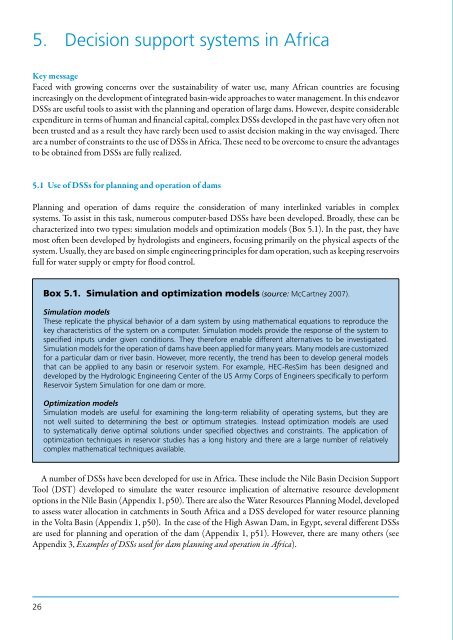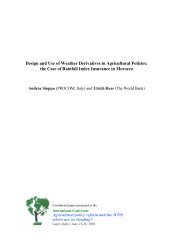Use of decision support systems to improve dam planning and dam ...
Use of decision support systems to improve dam planning and dam ...
Use of decision support systems to improve dam planning and dam ...
Create successful ePaper yourself
Turn your PDF publications into a flip-book with our unique Google optimized e-Paper software.
5. Decision <strong>support</strong> <strong>systems</strong> in Africa<br />
Key message<br />
Faced with growing concerns over the sustainability <strong>of</strong> water use, many African countries are focusing<br />
increasingly on the development <strong>of</strong> integrated basin-wide approaches <strong>to</strong> water management. In this endeavor<br />
DSSs are useful <strong>to</strong>ols <strong>to</strong> assist with the <strong>planning</strong> <strong>and</strong> operation <strong>of</strong> large <strong>dam</strong>s. However, despite considerable<br />
expenditure in terms <strong>of</strong> human <strong>and</strong> financial capital, complex DSSs developed in the past have very <strong>of</strong>ten not<br />
been trusted <strong>and</strong> as a result they have rarely been used <strong>to</strong> assist <strong>decision</strong> making in the way envisaged. There<br />
are a number <strong>of</strong> constraints <strong>to</strong> the use <strong>of</strong> DSSs in Africa. These need <strong>to</strong> be overcome <strong>to</strong> ensure the advantages<br />
<strong>to</strong> be obtained from DSSs are fully realized.<br />
5.1 <strong>Use</strong> <strong>of</strong> DSSs for <strong>planning</strong> <strong>and</strong> operation <strong>of</strong> <strong>dam</strong>s<br />
Planning <strong>and</strong> operation <strong>of</strong> <strong>dam</strong>s require the consideration <strong>of</strong> many interlinked variables in complex<br />
<strong>systems</strong>. To assist in this task, numerous computer-based DSSs have been developed. Broadly, these can be<br />
characterized in<strong>to</strong> two types: simulation models <strong>and</strong> optimization models (Box 5.1). In the past, they have<br />
most <strong>of</strong>ten been developed by hydrologists <strong>and</strong> engineers, focusing primarily on the physical aspects <strong>of</strong> the<br />
system. Usually, they are based on simple engineering principles for <strong>dam</strong> operation, such as keeping reservoirs<br />
full for water supply or empty for flood control.<br />
26<br />
Box 5.1. Simulation <strong>and</strong> optimization models (source: McCartney 2007).<br />
Simulation models<br />
These replicate the physical behavior <strong>of</strong> a <strong>dam</strong> system by using mathematical equations <strong>to</strong> reproduce the<br />
key characteristics <strong>of</strong> the system on a computer. Simulation models provide the response <strong>of</strong> the system <strong>to</strong><br />
specified inputs under given conditions. They therefore enable different alternatives <strong>to</strong> be investigated.<br />
Simulation models for the operation <strong>of</strong> <strong>dam</strong>s have been applied for many years. Many models are cus<strong>to</strong>mized<br />
for a particular <strong>dam</strong> or river basin. However, more recently, the trend has been <strong>to</strong> develop general models<br />
that can be applied <strong>to</strong> any basin or reservoir system. For example, HEC-ResSim has been designed <strong>and</strong><br />
developed by the Hydrologic Engineering Center <strong>of</strong> the US Army Corps <strong>of</strong> Engineers specifically <strong>to</strong> perform<br />
Reservoir System Simulation for one <strong>dam</strong> or more.<br />
Optimization models<br />
Simulation models are useful for examining the long-term reliability <strong>of</strong> operating <strong>systems</strong>, but they are<br />
not well suited <strong>to</strong> determining the best or optimum strategies. Instead optimization models are used<br />
<strong>to</strong> systematically derive optimal solutions under specified objectives <strong>and</strong> constraints. The application <strong>of</strong><br />
optimization techniques in reservoir studies has a long his<strong>to</strong>ry <strong>and</strong> there are a large number <strong>of</strong> relatively<br />
complex mathematical techniques available.<br />
A number <strong>of</strong> DSSs have been developed for use in Africa. These include the Nile Basin Decision Support<br />
Tool (DST) developed <strong>to</strong> simulate the water resource implication <strong>of</strong> alternative resource development<br />
options in the Nile Basin (Appendix 1, p50). There are also the Water Resources Planning Model, developed<br />
<strong>to</strong> assess water allocation in catchments in South Africa <strong>and</strong> a DSS developed for water resource <strong>planning</strong><br />
in the Volta Basin (Appendix 1, p50). In the case <strong>of</strong> the High Aswan Dam, in Egypt, several different DSSs<br />
are used for <strong>planning</strong> <strong>and</strong> operation <strong>of</strong> the <strong>dam</strong> (Appendix 1, p51). However, there are many others (see<br />
Appendix 3, Examples <strong>of</strong> DSSs used for <strong>dam</strong> <strong>planning</strong> <strong>and</strong> operation in Africa).





